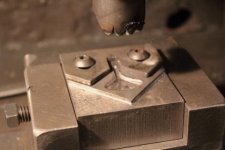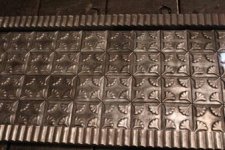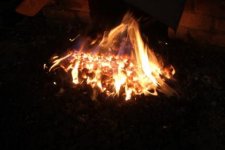Goat Marshall
Cast Iron
- Joined
- May 11, 2006
- Location
- Michigan, USA, the World
This is what I'm calling a "spring yoke" though I'm not sure that's the best name for it. I made it to form shapes around different forms. I've done this in the past by making a matching male and female pair, but the spring yoke makes it a lot easier, since this follows any form within its range--so now I only have to make the male. The arms are forged from 5160. Their position is adjustable for different sizes. There's a single nut in the middle which keeps the arms centered on the form (or off center if the form is asymmetrical). The whole outfit is held in the tool post, just like a cutting tool would be, with the clapper box locked.
The die plate is just a 3/8" plate held in the vise, drilled and tapped for various attachments. I think I've shown this here before but not with this spring thing. (Anyone have a good name for it?)
It's hard to imagine being without a shaper. It's one of the most useful machines I have. I use it more than a mill. This one is a 24" geared shaper (belt shifter) made by Smith and Mills some time before 1910, when they discontinued this model.
Here's a very short video of it working. I hope you enjoy it. Questions are welcome, of course.
Bending Hot Iron with Shaper and a Spring Yoke - YouTube
Joel Sanderson
The die plate is just a 3/8" plate held in the vise, drilled and tapped for various attachments. I think I've shown this here before but not with this spring thing. (Anyone have a good name for it?)
It's hard to imagine being without a shaper. It's one of the most useful machines I have. I use it more than a mill. This one is a 24" geared shaper (belt shifter) made by Smith and Mills some time before 1910, when they discontinued this model.
Here's a very short video of it working. I hope you enjoy it. Questions are welcome, of course.
Bending Hot Iron with Shaper and a Spring Yoke - YouTube
Joel Sanderson
















